
Allegedly established by a Roman centurion named Amarantus, Amarante is situated between the steep sides of Serra do Marão and the curves of the river Tâmega, the longest tributary of the river Douro. Modern Amarante is actually rooted in the 13th century, when the Benedictine monk St. Gonçalo settled in the area after completing a pilgrimage to Italy and Jerusalem. He is said to have commissioned the original bridge over the river Tâmega, located in the same spot as modern times.
In addition to its centurion, saint and bridge, Amarante is known for its sweets and cakes, and these are easy to find in many of the region's cake-shops and cafés. However, during the Feast of Sao Gonçalo, Amarante’s baked goods become famous for a different reason: they’re baked in the shape of phalluses, Sao Gonçalo is the patron saint of marriage and lovers. As suggestively shaped confections are not the norm for a Catholic Saint’s day, the tradition is likely rooted in a pagan fertility ritual.
Visitors to Amarante will want to take advantage of the region’s natural beauty and outdoor activities. Not to miss: hiking up to Serra do Marão in order to admire its breathtaking landscape. Near this mountain is Ansiães Valley. Here you will find trout farms on the right bank of the Ovelha River, as well as gorgeous sylvan scenery.
The village of Travanca da Serra, which is reached by the road leading to Peso da Régua, is an extremely picturesque spot, offering a magnificent panoramic view of the whole region. On fine days, you can see the mountains of Marão, Gerês and Cabreira. In the village itself, your attention is drawn to the Casa da Levada, belonging to the family of the late Portuguese writer Teixeira de Pascoais. Currently, the house is used as high-end tourist lodging. Also nearby: a well-preserved dolmen (stone burial mound) at Chão de Parada.